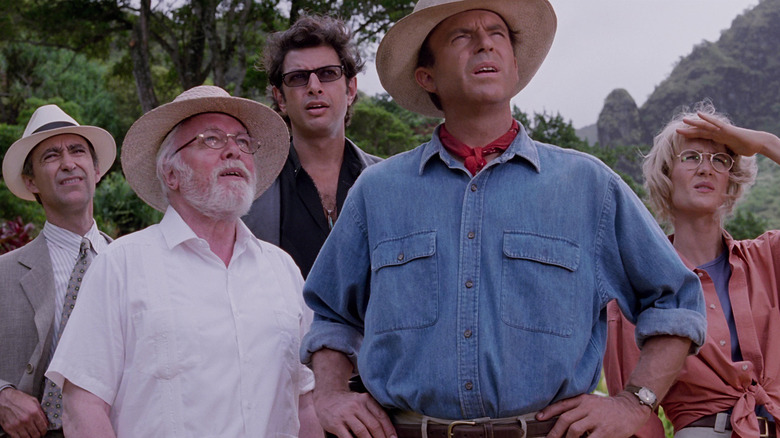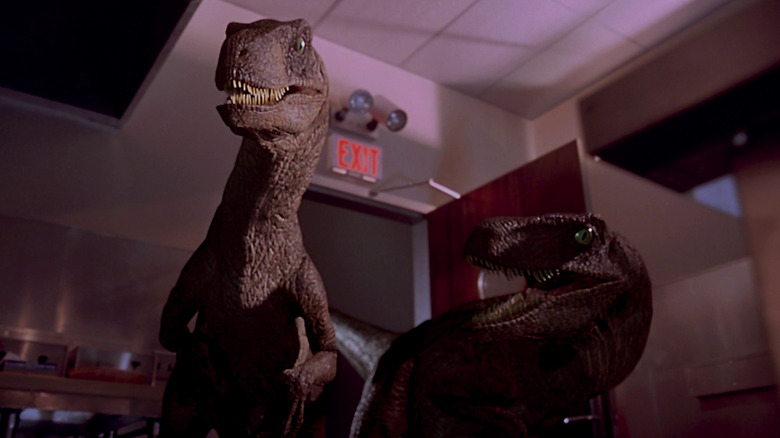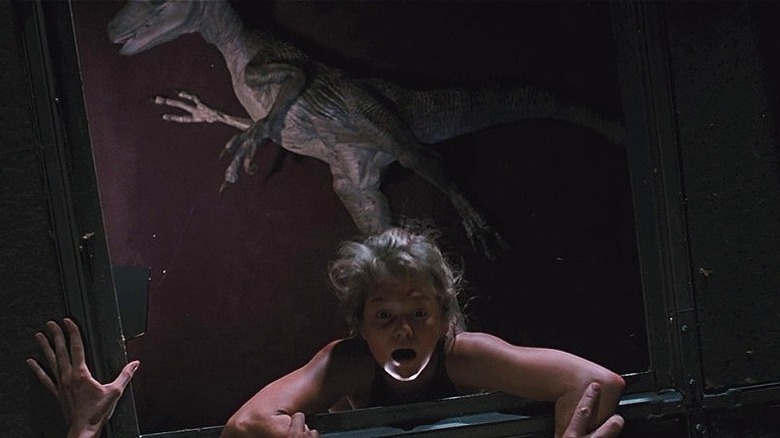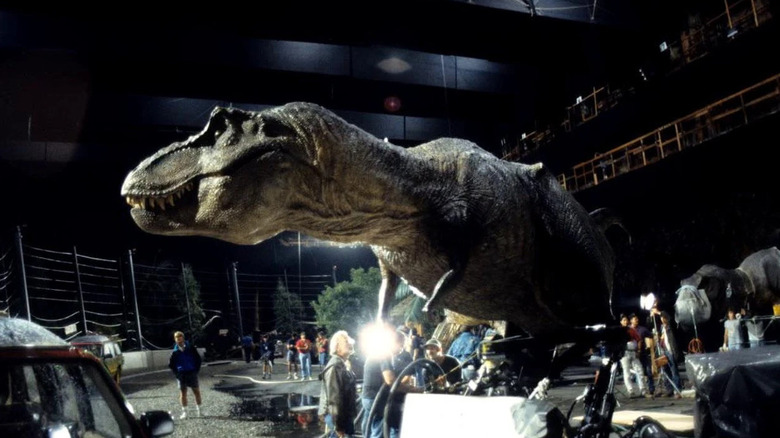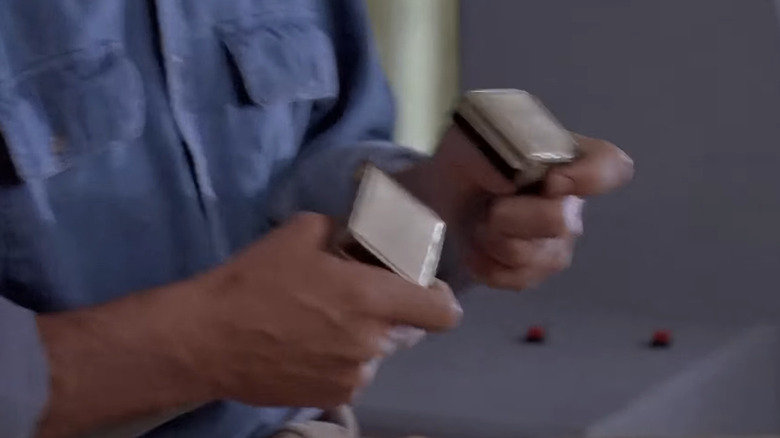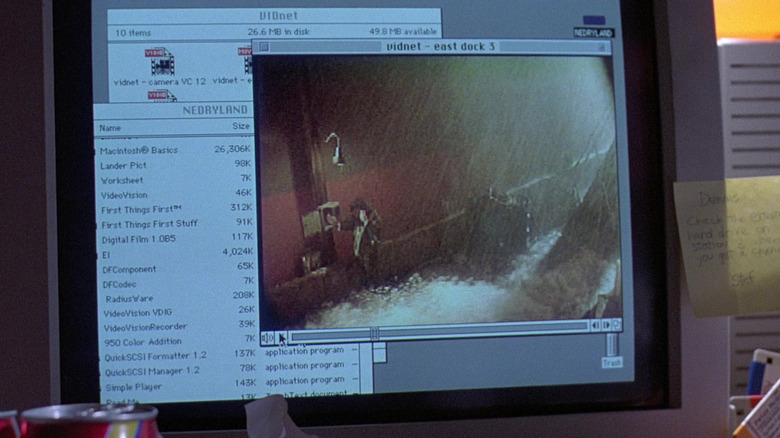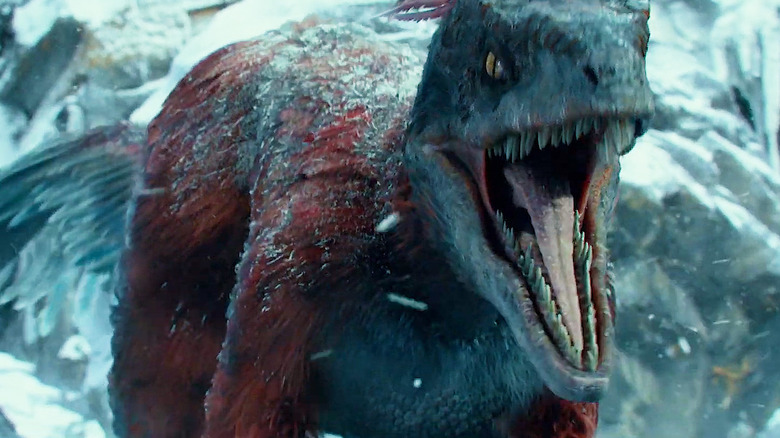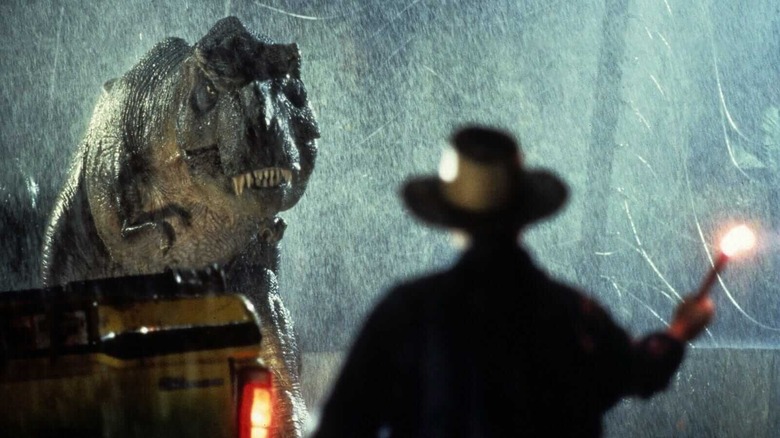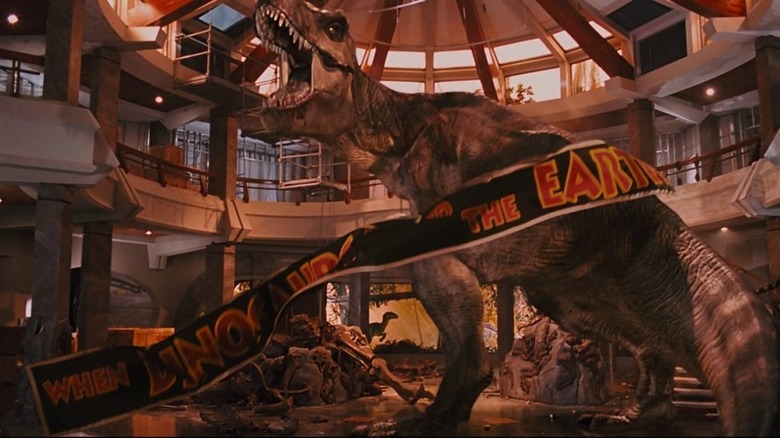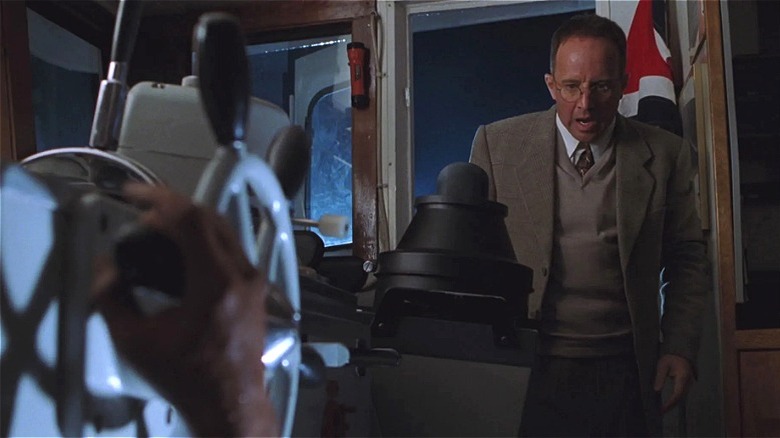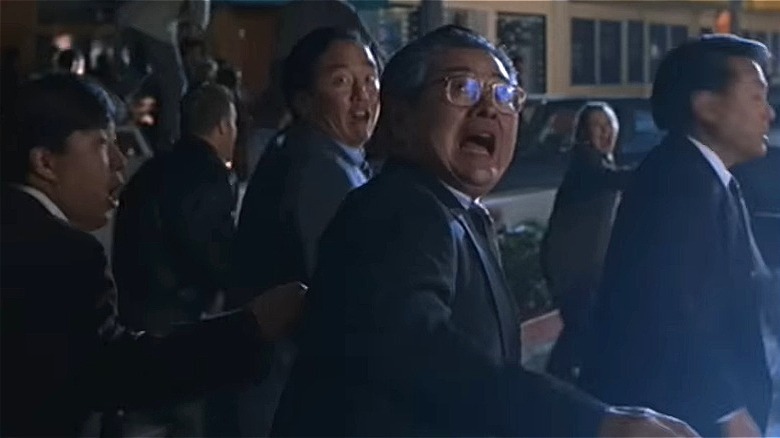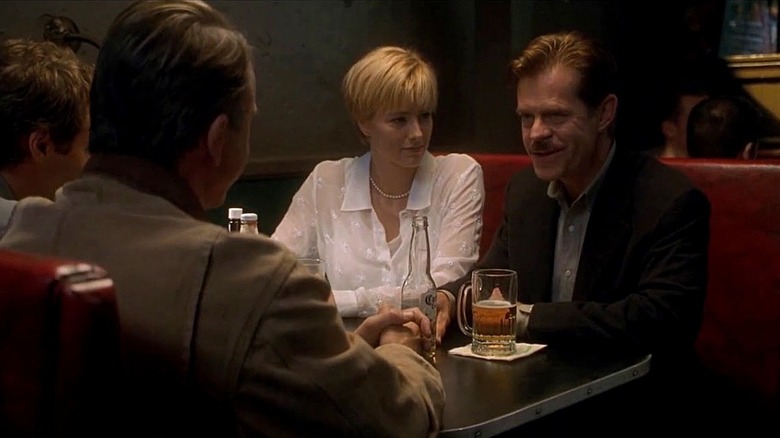We Rewatched The Jurassic Park Trilogy And It's Completely Different Now
Who hasn't thought about how cool it would be to live alongside dinosaurs at one point or another, and how many of us love the idea of exotic zoos? Those are the foundational fantasies underlying the "Jurassic Park" universe, which consists of six films — seven if you count the upcoming "Jurassic World Rebirth." Based on the best-selling 1990 novel by acclaimed author Michael Crichton, 1993's "Jurassic Park" film — directed by Steven Spielberg — follows the original novel pretty closely, spinning a story about an exclusive amusement park built on an island and whose main attraction is living, breathing dinosaurs! The park is funded by an eccentric billionaire, and before it opens, he brings in experts to give their opinions about the park, including two paleontologists, a mathematician (or "chaotician"), and — unwisely — his two grandchildren. Shenanigans, of course, ensue. Unfortunately, humanity doesn't learn its lesson, and the aforementioned sequels followed. However, we'll just be focusing on the original "Jurassic Park" trilogy, which includes the first film, 1997's "The Lost World: Jurassic Park," and 2001's "Jurassic Park III."
The first "Jurassic Park" and, to a lesser extent, its sequels, are eminently rewatchable. Not just because they're fun and engaging action-adventure films involving just about every badass dinosaur, but also because of all the details that are easily missed the first time around and the behind-the-scenes trivia that helps enhance the viewing experience. This includes missed plot holes, the accuracy or dubiousness of the franchise's science, how revolutionary the visual effects really were — and how dangerous the fake dinosaurs were, as well.
There is very little CGI in the first film
The original "Jurassic Park" is known for many things; however, one of the primary things it accomplished was to exponentially expand the use of computer-generated imagery (or "CGI") effects in film. To be clear, it's far from the first movie to use the technology; the first use of CGI in film was in 1976's "Futureworld," the sequel to 1971's "Westworld" (which, coincidentally, is a movie Michael Crichton both directed and wrote the book for, though he was mostly uninvolved in "Futureworld"). There was also the original "Star Wars," which used computers for the vector graphic Death Star seen during the Rebel debriefing, the world of "Tron," the water alien from "The Abyss," and the T-1000 in "Terminator 2: Judgment Day," among others. Nonetheless, "Jurassic Park" was the first to use CGI to render fully organic creatures rather than things like ships, water, liquid, and other non-biological things.
However, what's most fascinating to think about upon a rewatch is that, in total, there are only around 60 CG visual effects (or "VFX") shots in the entirety of the original "Jurassic Park." Due to technological limitations, time, money, etc., the dinos are still mostly animatronics and stunt guys in suits for the vast majority of the film. Still, it's immensely impressive what they were able to pull off in the early '90s. This is especially true when compared to modern films, including the "Jurassic World" movies, which, by comparison, utilize over 1500 CG VFX shots per movie.
First digital face replacement
Beyond the spectacle of recreating dinosaurs via CGI, "Jurassic Park" also has the distinction of pioneering another VFX breakthrough: the first digital face replacement ever put on film. While this is a common practice in most modern movies, particularly action blockbusters like the Marvel Cinematic Universe, it was absolutely unheard of in 1993, and we had no clue how groundbreaking it was at the time.
"Digital face replacement" is pretty much exactly what it sounds like. Essentially, digital effects artists use computers to replace one actor's face with another. In "Jurassic Park," this technique was used in the scene where Lexi (Ariana Clarice Richards), the eldest of John Hammond's two grandchildren, is escaping alongside other survivors inside of an air vent when a velociraptor peeks up through the bottom of the vent, ready to attack. Luckily, the raptor is kicked and falls to the ground below ... but, unfortunately, Lexi falls too, only grabbing the edge at the last minute. While filming, they had Richards' stunt double perform the fall, but the double looked up in the shot, so Spielberg got the effects team to use the aforementioned digital face replacement. While modern face replacements usually involve complete 3D CG models of actors' heads, in "Jurassic Park," they used a 2D mesh to replace the stunt double's face with Richards', frame-by-frame.
Then, in 1994 — a year after the release of "Jurassic Park" — digital face replacement was used in "The Crow" to add star Brandon Lee's visage to a number of scenes due to his untimely death.
T-Rex animatronic would really move on its own
As mentioned in a previous entry, there are actually surprisingly few CGI effects in the original "Jurassic Park." This means that when you see the Tyrannosaurus Rex on screen, it's most likely the giant, mechanical animatronic robot affectionately nicknamed Rexy behind the scenes. And it looked great and performed amazingly well ... when it actually worked, that is.
Due to the fake torrential rain that would pour down on set while filming Rexy's first attack scene, water got into the robot and caused it to malfunction. Worse, the malfunctioning electronics inside the giant, life-sized T-Rex animatronic (which was over 20 feet tall and weighed almost 9 tons) would cause it to move involuntarily, making it seem like a real life wild animal on set! It freaked the actors and crew on set whenever it moved, and at one point began chomping its jaws on its own! For the safety of everyone on set, the crew had to dry the dinosaur's rubber skin between takes. So, on rewatch, if viewers look closely, they can see that the T-Rex animatronic alternates between being dry and wet during its attack in the rain.
You'd think Spielberg would've learned not to mix mechanical electronics and water after his tumultuous time directing the temperamental shark robot — jokingly nicknamed "Bruce" after Spielberg's aggressive lawyer Bruce Ramer during the filming 1975's "Jaws" — that also famously broke down due to water getting into the large animatronic's sensitive electronics.
Seat belts foreshadow life finding a way
The most important theme in the "Jurassic Park" films involves the dangers of man playing God with nature. It's a warning dating back to arguably the first science fiction novel ever, Mary Shelley's "Frankenstein," and has been a mainstay in sci-fi stories ever since. In the film, billionaire John Hammond (Richard Attenborough) uses state-of-the-art biotechnology to genetically recreate dinosaurs in the modern day, thinking he can house them in the eponymous Jurassic Park for profit. This inevitably leads to disastrous results, because the way that his scientists had attempted to keep population control down in the park was by making all the dinosaurs female, an attempt to ensure it's impossible for them to breed. However, later in the film, Alan Grant (Sam Neill), one of the paleontologists Hammond invited to the park, finds eggs in the wild, revealing that "life found a way," regardless of the scientists' plan.
Rewatching the film, it becomes apparent that this revelation is foreshadowed early in the story. In the scene where Grant first rides Hammond's personal helicopter to the park, there's a small, easily forgettable moment where he can't buckle in since he only finds two female seat belt clips. However, Grant decides to tie the two female belts together, thus "finding a way." This could easily be dismissed as a simple character-building moment where the down-and-dirty blue-collar paleontologist is confused by his fancy new environment, but the thematic importance is apparent upon a follow-up viewing.
Status bar shown on live feed video
Dennis Nedry, played by Wayne Knight, is a schlubby computer programmer working at Jurassic Park. He oversees the most vital computer systems throughout the island and is instrumental in both the running of the park ... and its downfall. At the beginning of the film, we see Nedry meeting with BioSyn CEO Lewis Dodgson, a corporate rival to Hammond's company, InGen, who also wants to get in on the seemingly profitable dino cloning business. Dodgson then asks Nedry to commit corporate espionage against InGen for a large sum of money, which is easy for Nedry to agree to since he feels underappreciated and underpaid by Hammond.
All Nedry has to do is sneak into a lab, steal some tiny dinosaur embryos, hide them in a fake shaving cream can, and sneak off the island via boat. The plan almost works, and he even turns off the security system so he can slip out during the chaos. The only hitch is that he's sent a live feed video of a large tropical storm hitting the island, which shows the captain of his escape boat saying that he's leaving soon.
The problem with this scene upon rewatch, however, is that there's an obvious "status bar" on the bottom of the supposed live video feed — which means the video was pre-recorded. Admittedly, that status bar could be seen on first viewing, but the implication might not hit until you watch the film again. It's basically a blooper hidden in plain sight.
Dinosaurs are feathered
Both the novel and film version of "Jurassic Park" were at the cutting edge of paleontological science ... for its time, at least. Ever since the first proper discovery of dinosaur fossils in the early 19th century, paleontologists theorized that dinosaurs were giant, lumbering, tail-dragging lizards. In fact, the literal translation of the Latin "Tyrannosaurus Rex" is "Lizard King." This idea of dinosaurs as reptilian beasts persisted for decades and can be seen in many pop culture depictions, including 1933's "King Kong" and 1966's "One Million Years B.C.," among many others.
However, shortly before Crichton published "Jurassic Park," new theories were popularized, which upended those initial, long-standing beliefs about dinosaur anatomy. These theories speculate that instead of being lumbering and slow, dinosaurs were fast and dangerous. Even more shocking was the theory that dinosaurs eventually evolved into modern birds. Crichton incorporated these new scientific findings into his novel, which Spielberg adapted (relatively) faithfully.
However, again, while "Jurassic Park" was on the bleeding edge of paleontology in the early '90s, those newer theories were upended in the 21st century. It was then that a new theory was popularized — one that, at this point, has basically become accepted as common wisdom in modern paleontology — dinosaurs weren't actually scaly and reptilian, but rather feathered. In fact, this theory is so popular, it had to be addressed in 2022's "Jurassic World: Dominion," where Chris Pratt's Owen Grady fights off a feathered Pyroraptor.
100-foot drop comes out of nowhere in first T-Rex attack
One of the most exciting and memorable sequences in "Jurassic Park" by far is the first T-Rex attack in the rain after it escapes its high-tech paddock. It's visceral, it's intense, and it arguably has some of the best CGI in the film (even if the majority of the time it's on screen it's a giant, involuntarily moving animatronic). The attack occurs when the visiting characters are in Jeeps, taking a tour to see the exotic dinosaurs. When Nedry turns off the security system to make his doomed escape, it lets the dinos — including the aforementioned T-Rex — loose on the humans in the Jeeps.
Now, while the attack takes place on ground level, at one point, Alan Grant takes the kids into the loose T-Rex's paddock and climbs down a 100-foot drop to escape to relative safety. But, upon rewatching, that makes no sense. Where did that drop come from? They entered the Rex's paddock to climb down ... but where would the T-Rex have stood? It certainly didn't climb up with its tiny arms or, more absurdly, fly. Luckily, audiences simply didn't notice the first time around. Movie magic, baby!
T-Rex sneaks up in the end of Jurassic Park
At the end of the film, the surviving human characters are running away from the carnivorous velociraptors only to find themselves cornered and outmaneuvered by those clever girls! It looks like everyone is about to be munched on by a pouncing raptor — until the T-Rex comes out of nowhere and munches the attacking raptor first. Thus, the T-Rex becomes an unlikely hero, fighting off the raptors and saving the day while John Williams' score blasts the film's bombastic theme song as if it were the Rex's wrestling intro music. The raptors, meanwhile, are no longer interested in the humans and pounce on the Rex instead, though Rexy makes mincemeat of them despite being outnumbered. This fight allows the humans to finally escape to the Jeeps, drive to the helicopter pad, and fly off the island for good. The sequence then ends with the T-Rex roaring in triumph as a banner stating "When Dinosaurs Ruled the Earth" stylishly and symbolically falls in front of it.
It's such an amazing and exhilarating sequence that everyone overlooked the fact that it makes no freakin' sense.
The thing is, the T-Rex is a giant, lumbering beast. Everywhere it moves, the ground shakes. Heck, there's even that iconic scene where a single step from the Rex causes the water in a glass to ripple! So how come no one — especially the raptors — heard the Rex stomping around before attacking? Upon rewatching the film, it's hard to view this scene as anything but absurd ... even if it is admittedly badass.
Velociraptors in San Diego subplot of Lost World: Jurassic Park
It's no secret that most films have deleted scenes and excised subplots, and there's a rumored missing "The Lost World: Jurassic Park" detail that has long bothered fans, something that might have been excised mid-production. If true, this excised plot detail would've involved the velociraptors rampaging through the streets of San Diego, California, alongside the T-Rex. Unfortunately, for some reason, the raptors were left out, and only the T-Rex was allowed to have any fun in the city.
In the film, John Hammond loses control of his company, InGen, to his evil nephew, Peter Ludlow (Arliss Howard). Ludlow, meanwhile, plans on not only continuing the legacy of Jurassic Park — despite the disaster at Isla Nublar — but is, in fact, doubling down by creating a Jurassic Park in the middle of San Diego. Worse, construction on the new park has already begun.
The next step, of course, is bringing dinosaurs to the southern California location which, in the film, consists of a T-Rex and its child. However, remnants of the supposed inclusion of raptors appear to have made the final cut. In a scene that definitely pushed the PG-13 rating, when the ship carrying the dinosaurs shows up, authorities inspect it only to find bloody limbs in the cramped bridge. Upon rewatch, though, it makes no sense; given the size of the T-Rex, and the fact it went straight from the holding area to the streets, there's no way that the Rex could have killed the crew. Only raptors could have created this carnage.
Japanese men reference Godzilla in The Lost World: Jurassic Park
As mentioned in the previous entry, the antagonist of "The Lost World" is John Hammond's amoral nephew, who wants to send the T-Rex to the newly constructed Jurassic Park in San Diego. And, as we also mentioned, things go awry when the T-Rex escapes from its confinement and stomps into the city (sans raptors), causing mayhem throughout the streets in the last act of the film.
Unfortunately, it's not as cool as you'd expect "T-Rex in the city" mayhem would be, and the sequence mostly just consists of comedic sight gags (such as ridiculous fake movie posters shown briefly as the Rex crashes into a Blockbuster store ... remember those?) and a goofy incursion into suburbia.
These inconsequential comedic interludes reach their nadir when the T-Rex chases down a group of Japanese businessmen, with one of them yelling out in his native language. Now, there are no subtitles, so unless a viewer already knows Japanese, it's impossible to decipher exactly what they're saying. However, even if you don't speak the language, it's not impossible to understand that Spielberg and the scene are referencing Godzilla. The screenwriter later confirmed that the reference was intentional, with the businessman yelling, "I left Tokyo to get away from this," a joke that, honestly, didn't age very well.
Foreshadow of family lying in Jurassic Park III
The plot of 2001's "Jurassic Park III" is pretty simple. It follows our favorite paleontologist, Alan Grant, who has fallen on hard financial times while seeking funding for his velociraptor research. He is eventually enticed to return to a now-ruined Jurassic Park by a rich couple, Paul (William H. Macy) and Amanda (Téa Leoni) Kirby, who agree to pay for his research if he acts as their guide on the island. But why do they want to go there in the first place? Well, it turns out their son, Eric (Trevor Morgan), went missing while sailing near the never-opened theme park, and they need Grant's help to find him. Grant reluctantly agrees for the sake of science — and the money.
Unfortunately, once they're all trapped on the island, it's revealed that the Kirbys are, in fact, not rich; they were just desperate for Grant's help. Worse, he has no experience on the island their son is trapped on because Grant's adventure was on Isla Nublar, from the first film, while the island they're on is Isla Sorna from "The Lost World."
Interestingly, this twist is foreshadowed earlier in the film, and upon rewatching it, it's easy to spot the various clues that give away their subterfuge. Besides dodgy answers and half-truths, the song "Big Hat, No Cattle," by Randy Newman, plays as Macy's Paul gives Grant the fake check in a bar. It's a country song that's about a liar ... in fact, when Grant takes Paul's check, Newman sings, "I lied, lied, lied" in the background.
